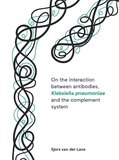On the interac+ons between an+bodies, Klebsiella pneumoniae and the complement system

Lans, Sjors van der
- Promoter:
- Prof.dr. S.H.M. (Suzan) Rooijakkers
- Co-promoter:
- Dr. B.W. (Bart) Bardoel
- Research group:
- Rooijakkers
- Date:
- February 13, 2024
- Time:
- 16:15 h
Summary
The human body is in constant contact with bacteria and relies on the immune system to ward off infections. Weakened immune defenses make individuals susceptible to bacterial infections. Antibiotics can be used to treat infections but development of antibiotic resistance by bacteria makes treatment of infections increasingly difficult. Combatting infections with antibiotic resistant requires innovative therapies. Utilizing antibodies to activate the immune system emerges as a promising strategy but requires a thorough understanding of the interactions between bacteria, antibodies and the immune system. In this work we aimed to understand the complex interactions between antibodies, K. pneumoniae (presently one of the most problematic antibiotic resistant bacteria), and human the complement system (a network of proteins in the blood that plays a crucial role in the immune response).
Antibiotic resistance poses a challenge to conventional infection treatments and can alter bacterial sensitivity to components of the immune system. In chapter 2, the impact of developing resistance to the last-resort antibiotic colistin on the sensitivity of K. pneumoniae to the membrane attack complex (MAC) was investigated. Colistin-sensitive K. pneumoniae strains were evolved in the lab to become colistin-resistant, revealing that two out of three resistant strains became more sensitive to MAC. The in-depth analysis of one strain (Kp209_CSTR) identified an active PhoQ protein due to a mutation in the phoQ gene, rendering the strain both colistin-resistant and MAC-sensitive. Examination of complement activation in human blood serum highlighted the crucial role of IgM antibodies in activating complement on this strain, emphasizing how colistin resistance can influence immune recognition of K. pneumoniae.
To study complement activation by antibodies in detail, using monoclonal antibodies against various antigens is essential. In chapter 3, we developed a method to identify novel antibodies against bacteria. Memory B cells, which express the antibodies they produce on their surface as B cell receptors (BCR), were utilized. By labeling K. pneumoniae fluorescently and mixing them with human B cells, bacteria-binding B cells could be individually sorted using a cell sorter. Subsequently, their antibodies were recombinantly expressed and tested. Using different K. pneumoniae strains (KpnO1 and KpnO2), a total of 29 unique antibodies were found. All seventeen antibodies against KpnO1 bound to the O1-antigen surface sugar, with thirteen activating the complement system. Among the twelve antibodies against KpnO2, nine bound to the O2-surface sugar, and three to the KpnO2 capsule. While all anti-O2 antibodies could activate the complement system, the anti-capsule antibodies could not. This underscores the significance of the antigen for the complement activation potential of an antibody. Complement-activating anti-O1 & O2 antigen antibodies also induced phagocytosis by neutrophils. Mixing anti-capsule revealed that these efficiently activate the complement system in a collaborative.
K. pneumoniae primarily causes hospital infections, including in immunocompromised patients who have undergone a kidney transplantation. These patients are at high risk of developing infection due to urinary tract damage and immunosuppressive medications. In chapter 4, the polyclonal antibody response to K. pneumoniae infection was studied in two kidney transplant patients. We determined that both patients produced specific antibodies against infectious K. pneumoniae. Using flow cytometry and mass spectrometry analysis we investigated the polyclonal antibody responses in these patients on a clonal level. We found that both patients were able to elicit a specific antibody response to the infectious bacteria, consisting of various clones. Although the antibodies produced by both patients activated the complement system and initiated complement-dependent phagocytosis, the presence of antibodies did not guarantee protection, as the patients still suffered from K. pneumoniae infections.
The research presented in this work reveals the intricate interaction between antibodies, K. pneumoniae, and the complement system. Crucially, the antigen's role in the complement activation potential of antibodies was highlighted. It emphasized the significance of inducing complement-mediated phagocytosis and demonstrated that combining different antibodies significantly enhances complement activation. This thesis contributes to expanding knowledge on antibody-mediated complement activation in K. pneumoniae, holding potential implications for the development of antibody-based treatments for K. pneumoniae infections.